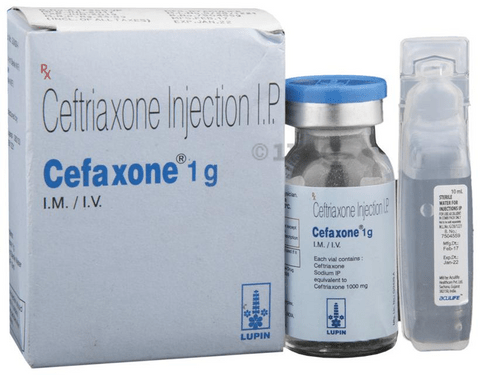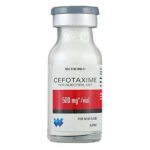Cefaxone Injection 1g: Uses, Dosage, Side Effects, Interactions

Cefaxone is a brand of ceftriaxone (1000mg) manufactured by Lupin Ltd. Ceftriaxone injection is in a class of medications called cephalosporin antibiotics. It works by killing bacteria. Cefaxone injection is used to treat certain infections caused by bacteria such as gonorrhea (a sexually transmitted disease), pelvic inflammatory disease (infection of the female reproductive organs that may cause infertility), meningitis (infection of the membranes that surround the brain and spinal cord), and infections of the lungs, ears, skin, urinary tract, blood, bones, joints, and abdomen.
Cefaxone injection is also sometimes given before certain types of surgery to prevent infections that may develop after the operation. Antibiotics such as Cefaxone injection will not work for colds, flu, or other viral infections. Using antibiotics when they are not needed increases your risk of getting an infection later that resists antibiotic treatment.
How should Cefaxone injection be used?
Cefaxone injection comes as a powder to be mixed with liquid, or as a premixed product, to be injected intravenously (into a vein) over a period of 30 or 60 minutes. Cefaxone injection can also be given intramuscularly (into a muscle). It is sometimes given as a single dose and sometimes given once or twice a day for 4-14 days, depending on the type of infection being treated.
You may receive Cefaxone injection in a hospital or doctor’s office, or you may administer the medication at home. If you will be receiving Cefaxone injection at home, your healthcare provider will show you how to use the medication. Be sure that you understand these directions, and ask your healthcare provider if you have any questions.
You should begin to feel better during the first few days of your treatment with Cefaxone injection. If your symptoms do not improve or get worse, call your doctor.
If you will be using more than one dose of Cefaxone injection, use the medication until you finish the prescription, even if you feel better. If you stop using Cefaxone injection too soon or skip doses, your infection may not be completely treated and the bacteria may become resistant to antibiotics.
What should I watch for while using Cefaxone?
Tell your doctor or health care provider if your symptoms do not improve or if they get worse.
This medicine may cause serious skin reactions. They can happen weeks to months after starting the medicine. Contact your health care provider right away if you notice fevers or flu-like symptoms with a rash. The rash may be red or purple and then turn into blisters or peeling of the skin. Or, you might notice a red rash with swelling of the face, lips, or lymph nodes in your neck or under your arms.
Do not treat diarrhea with over-the-counter products. Contact your doctor if you have diarrhea that lasts more than 2 days or if it is severe and watery.
If you are being treated for a sexually transmitted disease, avoid sexual contact until you have finished your treatment. Having sex can infect your sexual partner.
Calcium may bind to this medicine and cause lung or kidney problems. Avoid calcium products while taking this medicine and for 48 hours after taking the last dose of this medicine.
What are the side effects of Cefaxone?
Side effects that you should report to your doctor or health care professional as soon as possible:
• allergic reactions like skin rash, itching or hives, swelling of the face, lips, or tongue
• breathing problems
• fever, chills
• irregular heartbeat
• pain when passing urine
• redness, blistering, peeling, or loosening of the skin, including inside the mouth
• seizures
• stomach pain, cramps
• unusual bleeding, bruising
• unusually weak or tired
Side effects that usually do not require medical attention (report to your doctor or health care professional if they continue or are bothersome):
• diarrhea
• dizzy, drowsy
• headache
• nausea, vomiting
• pain, swelling, irritation where injected
• stomach upset
• sweating
This list may not describe all possible side effects. Call your doctor for medical advice about side effects. You may report side effects to FDA at 1-800-FDA-1088.
What may interact with Cefaxone?
Do not take Cefaxone with any of the following medications:
• intravenous calcium
This medicine may also interact with the following medications:
This list may not describe all possible interactions. Give your health care provider a list of all the medicines, herbs, non-prescription drugs, or dietary supplements you use. Also tell them if you smoke, drink alcohol, or use illegal drugs. Some items may interact with your medicine.





